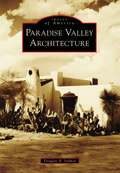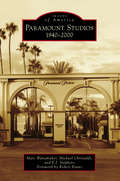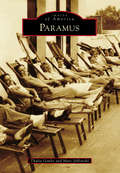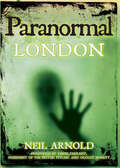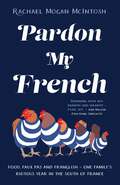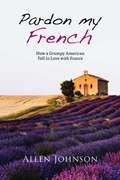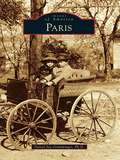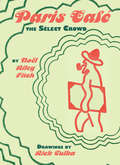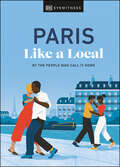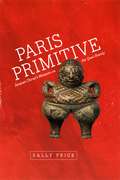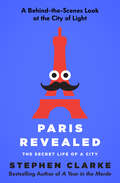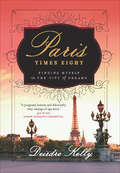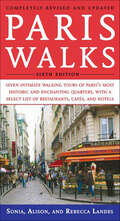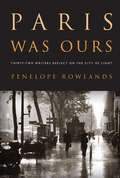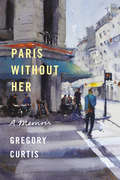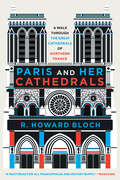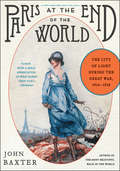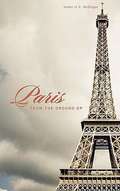- Table View
- List View
Paradise Valley Architecture
by Douglas B. SydnorThree surveyors in the late 19th century were so attracted to the area's desert beauty that they named it "the Paradise Valley." Starting in the 1920s, adobe homes were constructed in various revival styles. In 1936, the Camelback Inn resort set a high-quality standard with an inviting and relaxed character. Other guest lodges arrived, including the Hermosa Inn and the El Chorro Lodge. The 1950s brought more luxurious resorts, including the Paradise Valley Racquet Club and the Mountain Shadows Resort. With the threat of Phoenix or Scottsdale annexing the area, the citizens started debating incorporation in 1949 and were successful in 1961. Churches, schools, town facilities, and single-family homes followed. Numerous town ordinances were adopted to preserve a quiet, desert lifestyle such as burying all utilities, restrictive zoning, and hillside preservation.
Paramount Studios: 1940-2000 (Images of America)
by Robert Evans Marc Wanamaker E. J. Stephens Michael ChristaldiThe fascinating tale of Hollywood powerhouse Paramount Pictures--beginning with its birth in the 1910s through the turbulent decade of the 1930s--was told in Early Paramount Studios by Marc Wanamaker, Michael Christaldi, and E.J. Stephens. Now the same authors are back to tell the next 60 years of the studio saga in Paramount Studios: 1940-2000, with a foreword by former Paramount head of production Robert Evans. This book picks up the story during the time of World War II--a successful era for the studio--which was followed by a decade of decline due to the upstart medium of television. By the 1960s, the studio teetered on the brink of bankruptcy before rebounding, thanks to several 1970s blockbusters, such as Love Story, The Godfather, and Chinatown. The tale continues through the final decades of the 20th century when Paramount showcased some of the greatest hits in its history.
Paramus
by Thalia Goulis Marc JablonskiLocated in central Bergen County, the vibrant borough of Paramus has been home to many people and cultures. Today, this suburb of New York City is a nationally distinguished shopping destination, but less than a century ago, it was almost entirely farmland. The Sprout Brook, which still runs alongside Route 17, divided the area into two distinct farming regions, one of which was responsible for the town's reputation as "the Celery Capital of the World." In 1922, Paramus branched off from Midland Township, transforming into its own prosperous community. An attraction at that time was the Bergen Pines Hospital, which initially put the town on the map. Other local attractions included the Arcola Amusement Park, eventually lost to a fire, as well as Paramus Lanes and the Paramus Skating Rink. In 1957, the Garden State Plaza opened, and by 1961, it had become one of the largest shopping malls in the country. Paramus showcases the rich community heritage of this Bergen County borough.
Paranormal London
by Neil ArnoldWith almost 2000 years of continuous habitation, it is no surprise that the city of London can boast a fascinating array of strange events and paranormal occurrences. From sightings of big cats such as the Southwark Puma and the Cricklewood Lynx to the terrifying tales of the Highgate Vampire and Spring-Heeled Jack, along with stories of mermaids, dragons, fairies and alien encounters, this enthralling volume draws together a bizarre and intriguing collection of first-hand accounts and long-forgotten archive reports from the capital's history. Richly illustrated with over sixty photographs, Paranormal London will invite the reader to view the city in a whole new light and will delight all those interested in the mysteries of the paranormal.
Pardon My French
by Cathy HapkaSeventeen-year-old Nicole dreams of spending the rest of her life with her boyfriend Nate. So when she finds herself on her way to Paris to study abroad without him, she's less than thrilled. Paris is filled with cars that move at the speed of light, edible snails, and a language that Nicole can't speak or read. Worst of all, Nicole feels lost without Nate. She's not sure she's capable of finding joie de vivre on her own, but with the help of some new friends--and a certain handsome Frenchman-- Nicole might find Paris as sweet as a café au lait after all.
Pardon My French: Food, faux pas and Franglish - one family's riotous year in the south of France
by Rachael Mogan McIntosh'Uproarious and deliciously wise... A pure delight.' Tori Haschka, A Recipe for Family At the school gate, when she accidentally kissed one new friend on the nose and called another a 'beautiful man-horse', Rachael realised that small-town France could hardly be more different to beach-side Australia. The smell of cigarettes replaced the tang of bone-broth and sprouted sourdough, the neighbours sometimes came to blows and under no circumstances would anyone wear activewear in public. Ever.Muddling through every interaction in terrible French pushed Rachael's family to their limits. Some days, everybody cried and ate their feelings with almond croissants. But the town of Sommières embraced these ragtag Australians, and the family fell in love with their temporary hometown and its outrageous gossip, cobblestoned beauty and kind, eccentric inhabitants.Pardon My French is a candid, hilarious love letter to family life and France with three valuable lessons for overcoming adversity: make home a beautiful nest, lean into the tough lessons and look for the comedy in everything.
Pardon My French: Food, faux pas and Franglish - one family's riotous year in the south of France
by Rachael Mogan McIntosh'Uproarious and deliciously wise... A pure delight.' Tori Haschka, A Recipe for Family At the school gate, when she accidentally kissed one new friend on the nose and called another a 'beautiful man-horse', Rachael realised that small-town France could hardly be more different to beach-side Australia. The smell of cigarettes replaced the tang of bone-broth and sprouted sourdough, the neighbours sometimes came to blows and under no circumstances would anyone wear activewear in public. Ever.Muddling through every interaction in terrible French pushed Rachael's family to their limits. Some days, everybody cried and ate their feelings with almond croissants. But the town of Sommières embraced these ragtag Australians, and the family fell in love with their temporary hometown and its outrageous gossip, cobblestoned beauty and kind, eccentric inhabitants.Pardon My French is a candid, hilarious love letter to family life and France with three valuable lessons for overcoming adversity: make home a beautiful nest, lean into the tough lessons and look for the comedy in everything.
Pardon My French: How a Grumpy American Fell in Love with France
by Allen JohnsonTo make a friend is a joy. To make a friend in another country is a wonderment--a small miracle. Pardon My French follows the lives of an American couple who have embraced a daunting mission: Not to be spectators in France, but to be absorbed by France. Amidst the minefields of linguistic faux pas, the perplexities of French gestures, the exquisite and often exotic cuisine, and the splendor of Christmas on the Mediterranean--see what it is like for an occasionally gruff American to be adopted into a new family. Witness the hugging, the teasing, and the laughter that follows, when nothing on earth could be more perfect. Experience what it is like to fall in love with the French. Follow the adventures of the author as he pits his rather staid and conventional driving skills against the French speed demons of Languedoc. Step into his sneakers as he tests his basketball prowess against the young French bucks adorned with backward ball caps and over-the-knee Chicago Bulls game shorts. Watch how he frolics in the Mediterranean Sea for the first time with a French topless companion. Marvel as he sits in with a world-class French jazz band. Observe him overcome his shyness in talking to the beautiful nude model from his painting class in the studio atop the village police station. Envision how he learns to dance the tango with his head upright, his chest expanded, and his strides befitting a newly adorned French god--one with sensuality on his mind.
Parfums: A Catalogue of Remembered Smells
by Philippe ClaudelFrom the sizzling sharpness of freshly cut garlic to the cool tang of a father's aftershave; the heady intoxication of a fumbled first kiss to the anodyne void of disinfectant and death, this is a decadently original olfactory memoir. In sixty-three elusive episodes we roam freely across the countryside of Lorraine, North-East France, from kitchen to farm to a lover's bed. Recognising the bittersweet nostalgia of a scent that slips away on the summer breeze, Claudel demonstrates again his impeccable grasp of the personal and the universal, interweaved with a rare self-deprecating charm. This is an evocative patchwork at once earthy and ethereal, erotic and heart-breaking. Claudel permits us a glimpse of moments that have driven him to delight or despair, creating through the fading aromas of the past fragments of humour, insight and quite intangible beauty.
Paris (Images of America)
by Daniel Jay GrimmingerIn 1806, Rudolph Bair came to Ohio from Pennsylvania and settled on one of the highest points in Stark County and called it Paris. After its establishment in 1814, this town became an important center of business and the arts. As a stagecoach stop on the main road from Pittsburgh to the West, this village evolved into a hub of American culture. By the late 1800s, Paris had dry goods stores, a drug store, two hotels, wagon factories, harness shops, shoe shops, blacksmith shops, a meat market, mills, a vinegar factory, and three churches. Local farmers also came to Paris to do business, worship in Paris's churches, and absorb the latest news. The legacy of this village and its surrounding farmland lives on here in photographs, artifacts, and descendents of early settlers.
Paris By Phone
by Pamela DruckermanThe magic of independence meets the meaning of home in the picture book debut of the #1 bestselling author of Bringing Up Bébé.When Josephine Harris decides that Paris is where she really belongs, all it takes is a quick call on her magical phone to whisk her away. The city of lights has fancy cafés, baguettes under every arm, the Eiffel Tower, and a fabulous new family who can't wait to show her around. The city is a feast for the senses, but each new discovery brings a pang of melancholy. There's something missing here. Could it be the person who loves Josephine's best--her own mother?From #1 bestselling author Pamela Druckerman comes a whimsically commercial picture that little travellers and little homebodies will love!
Paris Café: The Select Crowd
by Noel Riley FitchAcclaimed author Noël Riley Fitch, abetted by noted artist Rick Tulka, serves the dish on Select, the famous Montparnasse café that for nearly nine decades has been so vital to Paris and its intellectual denizens: from Hemingway, Beauvoir, Picasso, James Baldwin, and George Plimpton to the writers and artists who continue to work quietly there in the back room or heatedly debate every topic imaginable into the night. The artists have their work on the walls; the novelists include the café setting in their fiction. The quiet and drama of the Sélect world illustrates the centrality of cafés - particularly this one - to Parisian social, cultural, and intellectual life. Blending pithy profiles and witty drawings of clientele and staff, the book is organized around a history of the café, its daily and seasonal rhythms, particular colorful patrons, and even its typical café/brasserie food (including a few recipes).
Paris Guia Visual (Travel Guide)
by DK TravelLa guía más actualizada de ParísLa Guía DK Travel París cuenta con exclusivas ilustraciones, planos en 3D, itinerarios, explicaciones detalladas de los principales monumentos y recomendaciones de restaurantes, hoteles, mercados y locales nocturnos.También incluye información práctica sobre transportes, horarios y visitas.París es una ciudad única: rebosante de historia, con monumentos majestuosos, encantadoras placitas, célebres museos y maravillosos secretos por descubrir.Contempla impresionantes vistas desde la Torre Eiffel, admira obras de arte de primer orden en el Museo del Louvre, observa las magníficas vidrieras de la Sainte Chapelle, pasea por los Campos Elíseos y disfruta de la gastronomía francesa.¡Bienvenidos a París!Las guías de viaje DK son las más completas: con fotografías inspiradoras, formato ligero y contenidos dirigidos a todo tipo de viajeros.Las guías más actualizadas del mercadoMás de 65 destinos de todos los continentesFáciles de usarExclusivas ilustracione-----------------------------------------------------------------------------Make your trip to Paris extraordinaryA stroll along the Seine, lazy mornings with a coffee and croissant, or taking in world-famous art at the Louvre—whatever your dream trip involves, this DK travel guide is the perfect companion.Our updated guide brings Paris to life, transporting you there like no other travel guide does. It offers expert-led insights, trusted travel advice, detailed breakdowns of all the must-see sights, photographs on practically every page, and our hand-drawn illustrations, which take you inside the city’s buildings and neighborhoods.You'll discover:our pick of Paris’s must-sees and top experiencesbeautiful photography and detailed illustrations, taking you to the heart of Paristhe best spots to eat, drink, shop, and staydetailed maps and walks, which make navigating the region easyeasy-to-follow itinerariesexpert advice: get ready, get around, and stay safecolor-coded chapters to each part of Parisa lightweight format, so you can take it with you wherever you go
Paris In Mind
by Jennifer Lee“Paris is a moveable feast,” Ernest Hemingway famously wrote, and in this captivating anthology, American writers share their pleasures, obsessions, and quibbles with the great city and its denizens. Mark Twain celebrates the unbridled energy of the Can-Can. Sylvia Beach recalls the excitement of opening Shakespeare & Company on the Rue Dupuytren. David Sedaris praises Parisians for keeping quiet at the movies. These are just a few of the writers assembled here, and each selection is as surprising and rewarding as the next. Including essays, book excerpts, letters, articles, and journal entries, this seductive collection captures the long and passionate relationship Americans have had with Paris. Accompanied by an illuminating introduction,Paris in Mindis sure to be a fascinating voyage for literary travelers. Jennifer Allen * Deborah Baldwin * James Baldwin * Dave Barry * Sylvia Beach * Saul Bellow * Bricktop * Art Buchwald * T. S. Eliot * M. F. K. Fisher * Janet Flanner * Benjamin Franklin * Ernest Hemingway *Langston Hughes * Thomas Jefferson * Stanley Karnow * Patric Kuh * A. J. Liebling * Anaïs Nin * Grant Rosenberg * David Sedaris * Irwin Shaw *Gertrude Stein * Mark Twain * Edith Wharton * E. B. White From the Trade Paperback edition.
Paris Like a Local (Local Travel Guide)
by Bryan Pirolli DK Eyewitness Yuki HigashinakanoDiscover the hidden secrets of Paris, the city of lights, with this fantastic city guide that will have you vacationing like a local in no time at allWhether you&’re a first time to the city of love, or a returnee to Paris, this is the perfect guide to an authentic experience from a local&’s perspective. No matter how often you&’ve been to Paris, this stylist guide will help you discover even more authentic experiences in this magical cityThis one-of-a-kind travel guide to Paris includes: • Two-color, bold modern design with contemporary illustrations throughout • Narrative style throughout, making the local, personal voice central to every entry • Structured by six themes and subsequent sub-themes, rather than areas, to echo how people are traveling, rather than where. Themes include Eat, Drink, Shop, and more! • Each entry includes its unique address so readers can pinpoint precisely where they are heading • Each theme ends with a tour spread, dedicated to a specific interest or experience. For example, &“An Atypical Arty Afternoon&” and &“A Night Out Along the Seine&” • Created keeping in mind readers traveling in a post-Covid worldExperience France&’s capital like a true ParisianHome to cutting-edge haute cuisine, vibrant little cafes, elegant river-side gardens, and a shopping scene like no other, this charming city is bathed in style and romance! Go beyond the Eiffel Tower and the Louvre and unearth the secret side of the city. Who better to guide you to it than locals? From the best pâtisseries and wine bars to dreamy viewpoints and modern art spaces, this Paris guidebook will help you find all the local&’s favorite hangout spots and hidden haunts. Dine alfresco at a cute café in the Marais, cycle along the tree-lined Canal Saint-Martin, and bargain for vintage treasures at the city&’s beloved flea markets. More in the seriesFrom New York and London to San Francisco and Tokyo, there are more places to discover with these niche local guides! Written by the people who call it home, the Like A Local series from DK takes you beyond the tourist track to experience the heart and soul of each city!
Paris Primitive: Jacques Chirac's Museum on the Quai Branly
by Sally PriceParis Primitive recounts the massive reconfiguration of Paris’s museum world that resulted from Chirac’s dream, set against a backdrop of personal and national politics, intellectual life, and the role of culture in French society. Along with exposing the machinations that led to the MQB’s creation, Sally Price addresses the thorny questions it raises about the legacy of colonialism, the balance between aesthetic judgments and ethnographic context, and the role of institutions of art and culture in an increasingly diverse France.
Paris Revealed: The Secret Life of a City
by Stephen ClarkeA hilarious insider&’s guide to Paris by the author of 1000 Years of Annoying the French: &“Clarke&’s eye for detail is terrific&” (The Washington Post). Stephen Clarke may have adopted Paris as his home, but he still has an Englishman&’s eye for the people, cafés, art, sidewalks, food, fashion, and romance that make Paris a one-of-a-kind city. This irreverent outsider-turned-insider guide shares local savoir faire, from how to separate the good restaurants from the bad to navigating the baffling Métro system. It also provides invaluable insights into the etiquette of public urination and the best ways to experience Parisian life without annoying the Parisians (a truly delicate art). Clarke&’s witty and expert tour of the city leaves no boulevard unexplored—even those that might be better left alone.
Paris Times Eight: Finding Myself in the City of Dreams
by Deirdre Kelly&“Very engaging . . . This charming travel memoir shows us how a person and a city can grow and change in tandem.&” —Booklist Over eight visits to Paris, Deirdre Kelly has found herself—first as a nineteen-year-old and then later as a budding writer, a dance critic, and a fashion reporter. Subsequent visits—with her mother, her future husband, and later as a mother herself—have shown her that while some parts of Paris remain constant, her life is always evolving. More than just a beautiful and romantic backdrop for her self-discovery, Paris itself contributes to that discovery, emerging as a principal character in Kelly&’s life, an influence that inspires, guides, and teaches as she ages. A terrific gift for budding travelers, Francophiles, and women on their own path toward growth, this book reminds readers of their own favorite place. &“A poignant, honest, and deliciously sexy coming-of-age story.&” —Jan Wong, national bestselling author of Beijing Confidential &“Deirdre Kelly&’s writing is fast-paced and full of color and gives the reader an insider&’s view. She gets it right.&” —Sally Armstrong, national bestselling author of The Nine Lives of Charlotte Taylor &“Takes the reader on a colorful travelogue along the narrow streets of the Marais district, the spectacular Tuileries gardens and the bustling Galleries Lafayette department store . . . a fast-paced, breezy read, its substance subtly woven into a tale of a city whose glamour and beauty never fades.&” —Ottawa Citizen &“At times pensive, sardonic and laugh-out-loud funny, as it chronicles a real life with all its comedies and tragedies.&” —Calgary Herald
Paris Walks: Seven Intimate Walking Tours of Paris's Most Historic and Enchanting Quarters
by Sonia Landes Alison Landes Rebecca LandesThe perfect walking guide to Paris and its history, now in a thoroughly updated sixth editionFull of architectural detail, unique advice, and historical anecdotes, Pariswalks allows the reader to do as the Parisians do--take to the streets on foot to discover the secret splendors of one of the most beautiful cities in the world. Sonia, Alison, and Rebecca Landes lead the reader through the maze of Paris's hidden back streets and into the tiny shops, secluded courtyards, underground cellars, and serene interiors that tourists rarely see.In this newly revised edition, readers will find completely updated walks covering the most interesting neighborhoods of central Paris, from the Place de la Bastille to the Boulevard St.-Germain, and an all new tour of the Place de la Concorde. Each walk is easily completed in a morning or afternoon and suggests shopping, dining, and cultural stops.Featuring maps, more than forty black-and-white photographs, and a select list of restaurants and hotels, Pariswalks is the essential companion to the hidden wonders of the City of Lights.
Paris Was Ours: Thirty-two Writers Reflect on the City of Light
by Penelope RowlandsParis is “the world capital of memory and desire,” concludes one of the writers in this intimate and insightful collection of memoirs of the city. Living in Paris changed these writers forever. In thirty-two personal essays—more than half of which are here published for the first time—the writers describe how they were seduced by Paris and then began to see things differently. They came to write, to cook, to find love, to study, to raise children, to escape, or to live the way it’s done in French movies; they came from the United States, Canada, and England; from Iran, Iraq, and Cuba; and—a few—from other parts of France. And they stayed, not as tourists, but for a long time; some are still living there. They were outsiders who became insiders, who here share their observations and revelations. Some are well-known writers: Diane Johnson, David Sedaris, Judith Thurman, Joe Queenan, and Edmund White. Others may be lesser known but are no less passionate on the subject. Together, their reflections add up to an unusually perceptive and multifaceted portrait of a city that is entrancing, at times exasperating, but always fascinating. They remind us that Paris belongs to everyone it has touched, and to each in a different way.
Paris Without Her: A Memoir
by Gregory CurtisIn this moving, tender memoir of losing a beloved spouse, the longtime editor of Texas Monthly, newly widowed, returns alone to a city whose enchantment he's only ever shared with his wife, in search of solace, memories, and the courage to find a way forward.At the age of sixty-six, after thirty-five years of marriage, Gregory Curtis finds himself a widower. Tracy--with whom he fell in love the first time he saw her--has succumbed to a long battle with cancer. Paralyzed by grief, agonized by social interaction, Curtis turns to watching magic lessons on DVD--"a pathetic, almost comical substitute" for his evenings with Tracy.To break the spell, he returns to the place he had the "best and happiest times" of his life. As he navigates the storied city and contemplates his new future, Curtis relives his days in Paris with Tracy, piecing together the portrait of a woman, a marriage, parenthood, and his life's great love through the memories of six unforgettable trips to the City of Lights.Alone in Paris, Curtis becomes a tireless wanderer, exploring the city's grand boulevards and forgotten corners as he confronts the bewildering emotional state that ensues after losing a life partner. Paris Without Her is a work of tremendous courage and insight--an ode to the lovely woman who was his wife, to a magnificent city, and to the self we might invent, and reinvent, there.
Paris and Her Cathedrals
by R. Howard BlochFor history readers, travelers, and scholars alike, an indispensable behind-the-scenes guide to the great cathedrals of Paris. “So infectious is R. Howard Bloch’s passion for his subject that even those unable to do the traveling required will find in Paris and Her Cathedrals an inspiring guide to these time-hallowed masterpieces of medieval culture.” —Colin Jones, author of Paris and The Great Nation Over the years, R. Howard Bloch has become renowned for the insider tours of Paris that he gives to students abroad. Long sought after by travelers and history buffs for his near-encyclopedic knowledge of French cathedrals, the eminent French literature scholar finally shares his expertise with a wider audience. In Paris and Her Cathedrals, six of the most sublime cathedrals in the penumbra of Paris—Saint-Denis, Notre-Dame, Chartres, Sainte-Chapelle, Amiens, Reims—are illumined in magnificent detail as Bloch, taking us from the High Middle Ages to the devastating fire that set Notre-Dame ablaze in 2019, traces the evolution of each in turn. Written from the premise that “seeing is enhanced by knowing,” each chapter is organized along the lines of a walk around and then through the space of the cathedral, such that the actual or virtual visitor feels the rich sweep of the church, “the essence of these architectural wonders” (Antonia Felix). Animating the past with lush evocations of architectural splendor—from flying buttresses and jewel-encrusted shrines to hidden burial grounds and secret chambers—Bloch then contextualizes the cathedrals within the annals of French history. Here thrilling tales of kingly intrigue—as in Saint-Chapelle, where the pious King Louis IX amassed relics, including Christ’s crown of thorns—and audacious abbots are interspersed with anecdotes about the meeting of aristocratic and everyday life, culminating in “a rich, colorful narrative that clearly but expertly explains the history and symbolism of some of the world’s most magnificent buildings” (Ross King). To be read in preparation for an enlightened visit or merely to open a window upon the High Middle Ages in France, Paris and Her Cathedrals is a “revelation,” an “indispensable guide” (Garry Wills) to these awe-inspiring structures. Complete with the author’s own photographs, this beautifully illustrated volume vitally enhances our understanding of the history of Paris and its environs.
Paris at the End of the World
by John BaxterA preeminent writer on Paris, John Baxter brilliantly brings to life one of the most dramatic and fascinating periods in the city's history. During World War I, the terrifying sounds of the nearby front could be heard from inside the French capital; Germany's "Paris Gun" and enemy aviators routinely bombarded the city.And yet in its darkest hour, the City of Light blazed more brightly than ever. Its taxis shuttled troops to the front; its great railway stations received reinforcements from across the world; its grand museums and cathedrals housed the wounded; and the Eiffel Tower hummed at all hours, relaying messages to and from the trenches. At night, Parisians lived with urgency and without inhibition, embracing the lush and the libertine. The rich hosted parties that depleted their wine cellars of the finest vintages. Artists such as Pablo Picasso achieved new creative heights. And the war brought a wave of foreigners to the city for the first time, including Ernest Hemingway and Baxter's own grandfather, Archie, whose diaries he uses to reconstruct a soldier's-eye view of the war years.Uncovering a thrilling chapter in Paris's history, John Baxter's revelatory new book shows how this extraordinary period was essential in forging the spirit of the city we love today.
Paris for Beginners: A memoir about love, adventure and finding yourself in the city of lights
by Rachael CoopesEnchanting, amusing, life-affirming and wise.' Toni PearenSometimes the best compass to follow is your heart.Actress Rachael Coopes had a serious boyfriend and successful career in Australia when she was awarded a scholarship to study at a renowned clown school in Paris.It was the opportunity of a lifetime, so she upped sticks and fully surrendered herself to the possibilities of Paris. Cue a coveted pied-à-terre with a view of the Eiffel Tower, quaffing champagne at midnight with her glamorous new amies, and learning how to flirt in French. But for all its charm and sensual pleasures, Paris had a hard lesson or two to teach her about life, and love.Paris for Beginners is about growing up (even when you're already, supposedly, a fully-fledged adult) and figuring out what you need in life, set against the perennially alluring backdrop of the City of Lights.
Paris from the Ground Up
by James H. S. McgregorParis is the most personal of cities. There is a Paris for the medievalist, and another for the modernist-a Paris for expatriates, philosophers, artists, romantics, and revolutionaries of every stripe. James H. S. McGregor brings these multiple perspectives into focus throughout this concise, unique history of the City of Light. His panorama begins with an ancient Gallic fortress on the Seine, burned to the ground by its own defenders in a vain effort to starve out Caesar's legions. After ninth-century raids by the Vikings ended, Parisians expanded the walls of their tiny sanctuary on the Ile de la Cité, turning the river#x19;s right bank into a thriving commercial district and the Rive Gauche into a college town. Gothic spires expressed a taste for architectural novelty, matched only by the palaces and pleasure gardens of successive monarchs whose ingenuity made Paris the epitome of everything French. The fires of Revolution threatened all that had come before, but Baron Haussmann saw opportunity in the wreckage. No planned city in the world is more famous than his. Paris from the Ground Up allows readers to trace the city's evolution in its architecture and art-from the Roman arena to the Musée Orsay, from the Louvre's defensive foundations to I. M. Pei's transparent pyramids.
